
Astroscopus guttatus or the northern stargazer is a fish belonging to the Uranoscopidae family and was first described by Charles Conrad Abbott in 1860. Members of the Uranoscopidae family are characterized by dorsally or dorsolaterally directed eyes placed on or near the top of a large, flattened cuboid head, an oblique to vertical mouth often lined with cutaneous cirri, and an elongated, sub-compressed body. The Astroscopus genus consists of three species: Astroscopus guttatus, Astroscopus Y-graecum, and Astroscopus zepherus. Typically found on the Atlantic shores between the states of North Carolina and New York in the United States, the Northern Stargazer can sometimes be confused with its sister species the Southern Stargazer, Astroscopus y-graecum. Both A. guttatus and A. Y-graecum overlap in their distributions in Cape Hatterus One way to distinguish the Northern Stargazer from the Southern Stargazer is by the presence of numerous small white spots closely spaced along its head and back, whereas the Southern Stargazer has fewer, larger spots on its back. The Northern Stargazer is a moderately sized fish that can reach lengths of 22 inches (56 cm). The northern stargazer can be found buried in sandy substrate at depths up to 120 feet where the species remains buried awaiting prey. Stargazers have a flat forehead with a lot of body mass up front near the mouth creating a body plane optimal for remaining buried under sandy substrate.
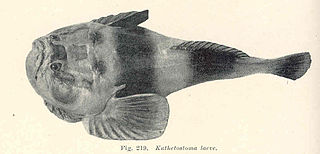
The stargazers are a family, Uranoscopidae, of labriform ray-finned fish that have eyes on top of their heads. The family includes about 51 species in eight genera, all marine and found worldwide in shallow and deep saltwaters.

Ceratiidae, the warty sea devils, caruncled seadevils or seadevils, are a family of marine ray-finned fishes belonging to the suborder Ceratioidei, the deep-sea anglerfishes, in the anglerfish order Lophiiformes. The warty sea devils are sexually dimorphic with the small males being obligate sexual parasites of the much larger females. The fishes in this family are widely distributed from polar to tropical seas around the world.

The longheaded eagle ray is a species of eagle ray in the family Myliobatidae. The longheaded eagle ray, like other members of the genus Aetobatus, is characteristically different from other genera of eagle rays, distinguished by their notched nasal curtain; complete, singular set of upper and lower teeth; and v-shaped teeth in the lower jaw. It is found in the tropical and warm temperate Indo-West Pacific. It formerly included populations in the northwest Pacific, but these were recognized as a separate species, Aetobatus narutobiei, in 2013. Longheaded eagle rays are benthopelagic fishes that feed on crustaceans, cephalopods, echinoderms, and small bony fishes. It is a poorly known species, but generally uncommon and considered endangered by the IUCN.

Coastal fish, also called inshore fish or neritic fish, inhabit the sea between the shoreline and the edge of the continental shelf. Since the continental shelf is usually less than 200 metres (660 ft) deep, it follows that pelagic coastal fish are generally epipelagic fish, inhabiting the sunlit epipelagic zone. Coastal fish can be contrasted with oceanic fish or offshore fish, which inhabit the deep seas beyond the continental shelves.

Bellator egretta, the streamer searobin, is a species of marine ray-finned fish belonging to the family Triglidae, the sea robins. This fish is found in the western Atlantic Ocean.

Cryptacanthodes is a genus of marine ray-finned fishes belonging to the monogeneric family Cryptacanthodidae, commonly referred to as wrymouths. Three of the four species are found in the Pacific Ocean with one species native to the western Atlantic Ocean where they are benthic fishes, tunneling through soft substrates. It is currently the only known genus in its family.
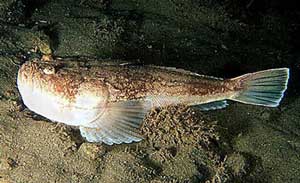
Uranoscopus is a genus of stargazer fish from the family Uranoscopidae. The name Uranoscopus is from the Greek, ouranos, "sky" and skopein, "to watch".

Dollfus' stargazer is a fish of the family Uranoscopidae, widespread in the Western Indian Ocean: Gulf of Suez, Gulf of Oman, and Persian Gulf. It is a marine demersal fish, and occurs at depths down to about 46 metres (151 ft). It was named in honour of Dr R. P. Dollfus who led an expedition to Egypt in 1928–1929 and who brought back some specimens of this fish which he mistakenly identified as Uranoscopus affinis. These were new to science and became the type specimens of the new species U. dollfusi, with the Gulf of Suez being the type locality.
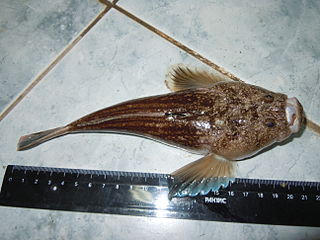
The Atlantic stargazer is a marine, subtropical fish of family Uranoscopidae. Its body is suited for living on the sea floor, and is one of few fish capable of bioelectrogenesis, or the ability to generate an electric charge.
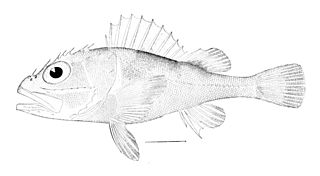
Trachyscorpia is a genus of marine ray-finned fish belonging to the subfamily Sebastinae, the rockfishes, part of the family Scorpaenidae. The species in this genus are found in the Atlantic, Indian and Pacific oceans.

The stargazing stonefish is a species of stonefish native to the Indian Ocean and the western Pacific Ocean where it is found on muddy bottoms in estuaries. This venomous species is also a minor component of local commercial fisheries. This species grows to a length of 8 centimetres (3.1 in) SL. This species is the only known member of the genus Trachicephalus.

Chirodactylus is a genus of marine ray-finned fish, traditionally regarded as belonging to the family Cheilodactylidae, the members of which are commonly known as morwongs. They are native to the Atlantic, Indian and eastern Pacific oceans off southern Africa and South America.
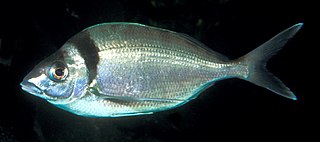
Nemadactylus is a genus of marine ray-finned fish, traditionally regarded as belonging to the family Cheilodactylidae, the members of which are commonly known as morwongs. They are found in the South Atlantic, Indian and South Pacific Oceans.
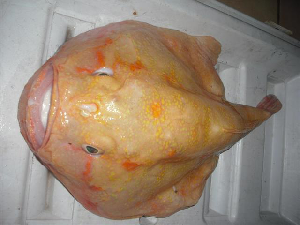
The furry coffinfish, also sometimes referred to the coffinfish, is a species of marine ray-finned fish belonging to the family Chaunacidae, the sea toads. It is found in salty temperate waters of southwestern Pacific, off east coast of Australia.

The southern stargazer is a species of marine fish in the family Uranoscopidae and genus Astroscopus. They are native to the United States.

Atractoscion is a genus of marine ray-finned fished belonging to the family Sciaenidae, the drums and croakers. The fishes in this genus are found in the Atlantic, Indian and Pacific Oceans.

Kathetostoma is a genus of bony fish from the family Uranoscopidae, the stargazers. They are demersal predators which are found in the western Atlantic, Pacific and Indian Oceans, with most species around Australia and New Zealand.

Lepidotrigla papilio, the spiny gurnard, butterfly gurnard, Eastern spiny gurnard or Southern spiny gurnard. is a species of demersal marine ray-finned fish belonging to the family Triglidae, the gurnards and sea robins. This species is endemic to Australia.

Scolopsis vosmeri, also known as Vosmaer's monocle bream, white-banded monocle bream, whitecheek monoclebream and whiteband spinecheek, is a species of marine ray-finned fish belonging to the family Nemipteridae, the threadfin breams. This species occurs in the eastern Indian Ocean and western Pacific Ocean.


















